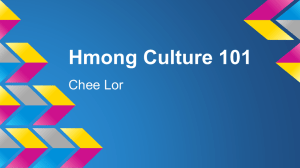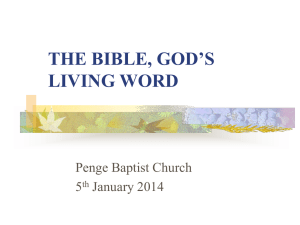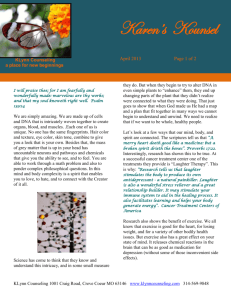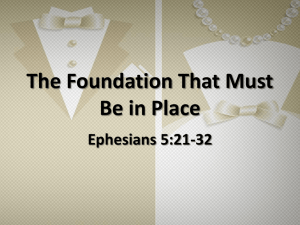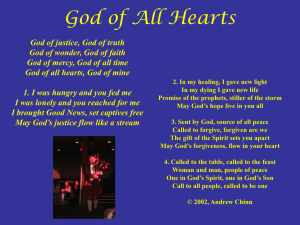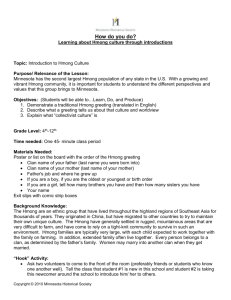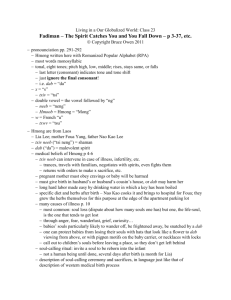Hmong Culture and Life
advertisement
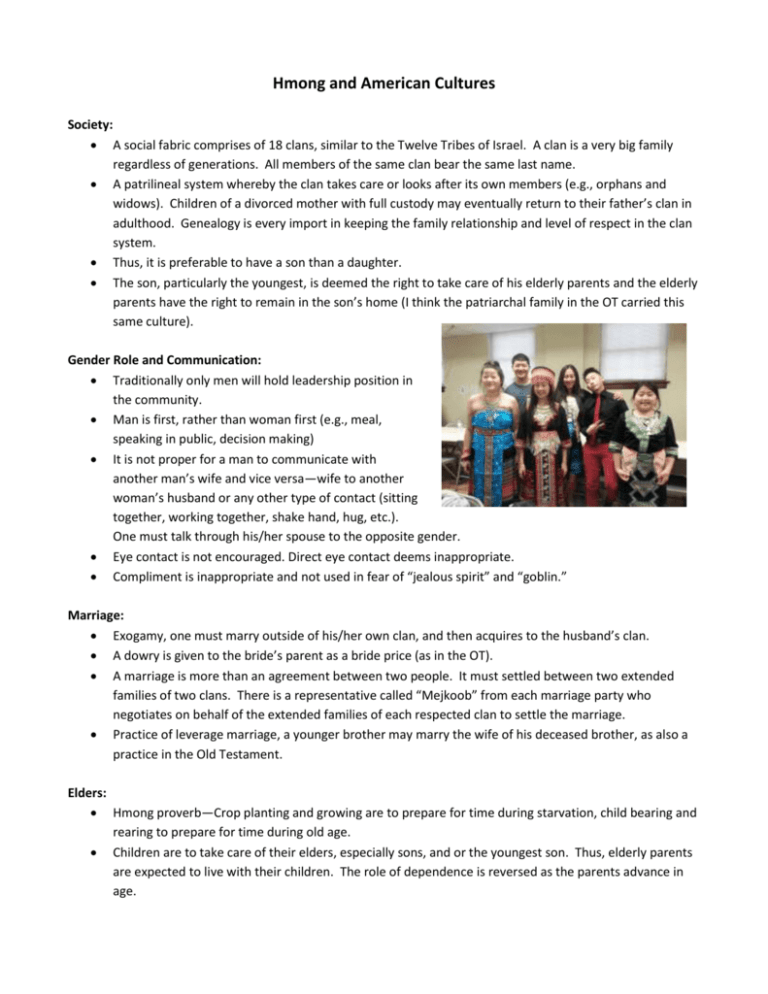
Hmong and American Cultures Society: A social fabric comprises of 18 clans, similar to the Twelve Tribes of Israel. A clan is a very big family regardless of generations. All members of the same clan bear the same last name. A patrilineal system whereby the clan takes care or looks after its own members (e.g., orphans and widows). Children of a divorced mother with full custody may eventually return to their father’s clan in adulthood. Genealogy is every import in keeping the family relationship and level of respect in the clan system. Thus, it is preferable to have a son than a daughter. The son, particularly the youngest, is deemed the right to take care of his elderly parents and the elderly parents have the right to remain in the son’s home (I think the patriarchal family in the OT carried this same culture). Gender Role and Communication: Traditionally only men will hold leadership position in the community. Man is first, rather than woman first (e.g., meal, speaking in public, decision making) It is not proper for a man to communicate with another man’s wife and vice versa—wife to another woman’s husband or any other type of contact (sitting together, working together, shake hand, hug, etc.). One must talk through his/her spouse to the opposite gender. Eye contact is not encouraged. Direct eye contact deems inappropriate. Compliment is inappropriate and not used in fear of “jealous spirit” and “goblin.” Marriage: Exogamy, one must marry outside of his/her own clan, and then acquires to the husband’s clan. A dowry is given to the bride’s parent as a bride price (as in the OT). A marriage is more than an agreement between two people. It must settled between two extended families of two clans. There is a representative called “Mejkoob” from each marriage party who negotiates on behalf of the extended families of each respected clan to settle the marriage. Practice of leverage marriage, a younger brother may marry the wife of his deceased brother, as also a practice in the Old Testament. Elders: Hmong proverb—Crop planting and growing are to prepare for time during starvation, child bearing and rearing to prepare for time during old age. Children are to take care of their elders, especially sons, and or the youngest son. Thus, elderly parents are expected to live with their children. The role of dependence is reversed as the parents advance in age. Elders are to rest and wait on their children to take care of them, especially cooking and chores around the house, financial and healthcare responsibility. Adult children are in charge of the household. Again, a reversal of role. Elders are to be respected regardless; mistreatment of elders is cursed and guaranteed misfortune and downfall in the future. Health and Healing: Warm or hot water, rather than cold or ice water, is preferred for drinking during illness or recovery to prevent future health complication. Diet may cause or be related to illness. Strict diet must be taken for precaution during illness or recovery. The loss of soul is the primary cause of illness and/or misfortune (as comparing to disease, germs, genetic heredity, aging, accident, lack of healthcare and prevention). Hmong believe that the soul and the body are integral parts of a healthy life. The plight or loss of the soul (soul leaving the body or being capture by offended spirit, sometime described as “spirit falls”) will trigger illness or any misfortune and may cause death if no sacrifice made to appease the offended spirit. The shaman is called to diagnose whether or not the illness or misfortune is caused by an offended spirit and for what reason. If so, through a trance of ritual healing, the shaman enters the spirit world going after the lost soul, negotiates and makes a promise of an acceptable sacrifice to appease the offended spirit who has detained the soul in order to retrieve the soul back to the body. Thus, when the spirit falls, illness occurs. When the spirit returns to the body, healing occurs. Birth and Death: There is birth and rebirth. Life is a cycle. Birth and death are divine predestination, no one knows the time and no one can prevent it from happening. Death is one’s fate. Accepting is the norm. No question asked as to why the righteous suffer? Death has nothing to do with economic status, healthcare accessibility, punishment, etc., of an individual’s fate. In dying, the deceased makes a long journey to the ancestor’s world, tracing backward to its birthplace and beyond to the ancestor’s world. The realm of the ancestors is the underworld, the afterlife world, where the spirit of the deceased goes and waits for a chance to be reborn. The realm of the ancestors is described as a place of darkness, desert, cold, scarcity and starvation. Also believe that death occurs when “spirits of deceased relatives or ancestors” or “goblins” just want to take you away from the physical world. Yes, Hmong believe in goblins. Beware! You don’t want to be a target. A typical Hmong funeral is conducted for three to four days long here in the United States. In Asia, it may take as long as seven days. Hmong burial site is specially selected for good fortune and blessing for the future generations.

